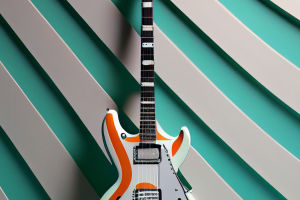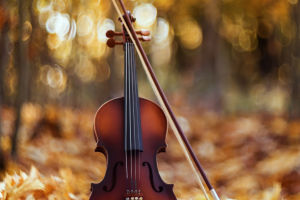
Guitar Evolution Journey

The guitar is a widely used plucked string instrument with a history that dates back thousands of years.
The guitar’s origins can be traced back to ancient Middle Eastern and Central Asian regions, where early guitar-like instruments were used in musical performances. These instruments, often equipped with four or more strings, served both as tools for accompaniment and melodic expression.
The modern guitar took shape in Europe during the Middle Ages, especially in Spain and Portugal, with the development of the “vihuela.” Popular during the Renaissance, the vihuela served as a precursor to the modern guitar. By the late 18th and early 19th centuries, the instrument had undergone significant transformations, evolving into the recognizable form we see today.
Related
 Electric guitars electrify music with their powerful sound and rich history of innovation!
Electric guitars electrify music with their powerful sound and rich history of innovation!
 The violin, a timeless symbol of art, blends rich history with emotional expression in every note.
The violin, a timeless symbol of art, blends rich history with emotional expression in every note.
 In today's world, prioritize furniture over decor for personalized, functional spaces.
In today's world, prioritize furniture over decor for personalized, functional spaces.
 Art transcends life, offering a space for spiritual exploration and expression.
Art transcends life, offering a space for spiritual exploration and expression.
 Türkiye's vibrant mosaic lamps illuminate its cultural tapestry.
Türkiye's vibrant mosaic lamps illuminate its cultural tapestry.
 France's diverse architecture reflects centuries of artistry.
France's diverse architecture reflects centuries of artistry.
Types of Guitars
Guitars are mainly divided into two categories: acoustic guitars and electric guitars.
1. Acoustic Guitar
The acoustic guitar is the most common type of guitar, typically made of wood. Its sound is produced by the vibration of the strings, which is transmitted to the body and then amplified through the soundbox. Acoustic guitars are further divided into classical guitars and folk guitars.
-Classical Guitar: Classical guitars usually use nylon strings and have a wide, flat fingerboard, making them suitable for classical music and some modern popular music. They are smaller in size with a soft and warm tone.
-Folk/Steel-String Acoustic Guitar: Folk guitars use steel strings, they are larger in size, and produce a louder volume. They have a bright, clear sound and are suitable for various musical styles, such as folk, country, and rock.
2. Electric Guitar
The electric guitar, a landmark innovation in 20th-century music, generates sound through pickups and amplifiers, typically without the need for a hollow soundbox. Its design allows for a vast range of tonal possibilities and effects control, making it a staple in genres like rock, blues, jazz, metal, and many others.
-Solid-Body Electric Guitar: The electric guitar lacks a hollow soundbox, with pickups directly capturing the vibrations of the strings. This design minimizes feedback noise, making it highly suitable for high-volume performances.
-Semi-Hollow Electric Guitar: This type of guitar combines the features of both solid and hollow-body designs. It includes resonance chambers that enhance tonal richness but can be more susceptible to feedback noise at higher volumes.
Structure and Materials
The structure of a guitar typically includes the headstock, neck, and body.
The headstock houses the tuners, which are used to adjust the string tension. The neck contains a fingerboard with frets—metal strips that define different pitches when the strings are pressed. The body serves as the primary resonance chamber; in acoustic guitars, it is typically hollow, while in electric guitars, it can be solid or semi-hollow to suit different tonal needs.
The materials used in a guitar play a crucial role in shaping its tone. Classical guitars commonly feature tops made from cedar or spruce, paired with back and sides crafted from rosewood, mahogany, or maple to enhance tonal richness. Folk guitars, on the other hand, may employ various wood combinations to achieve specific sound qualities. Electric guitars typically have bodies constructed from maple, alder, or mahogany, while their fingerboards are often made of rosewood or maple to influence playability and tonal clarity.
A history of the guitar in four minutes
Video by IPMusic / Early Music Muse
Cultural Influence
The guitar transcends its role as a mere instrument to serve as a powerful cultural symbol, deeply embedded in musical traditions across the globe. Its versatility and distinctive sound have made it an integral part of diverse genres and cultures, reflecting the heritage and emotions of countless communities.
From the passionate rhythms of Spanish Flamenco to the soulful melodies of American blues and the electrifying riffs of rock, the guitar is a cornerstone of global music. It has seamlessly integrated into genres ranging from classical compositions to modern pop hits. Legendary guitarists such as Andrés Segovia, Jimi Hendrix, and Eric Clapton have left indelible marks on the world of music, each celebrated for their distinctive playing styles and groundbreaking contributions to the instrument’s legacy.

The guitar holds an indispensable position in modern music. Its portability, versatility, and rich expressiveness have made it one of the most beloved instruments globally. Whether at an intimate gathering for personal performances or on a grand concert stage, the guitar captivates audiences, delivering profound emotional depth and unparalleled musical enjoyment.
Conclusion
The guitar, with its rich history and dynamic presence, undeniably occupies a central role in the world of music. Whether you’re a passionate music lover, a curious beginner, or a seasoned musician, the guitar offers a versatile and deeply rewarding musical journey.